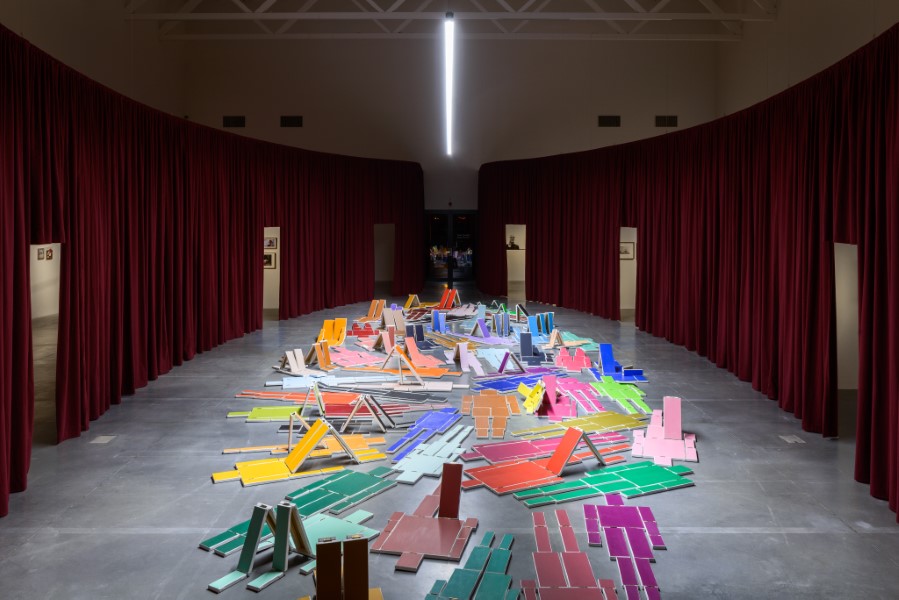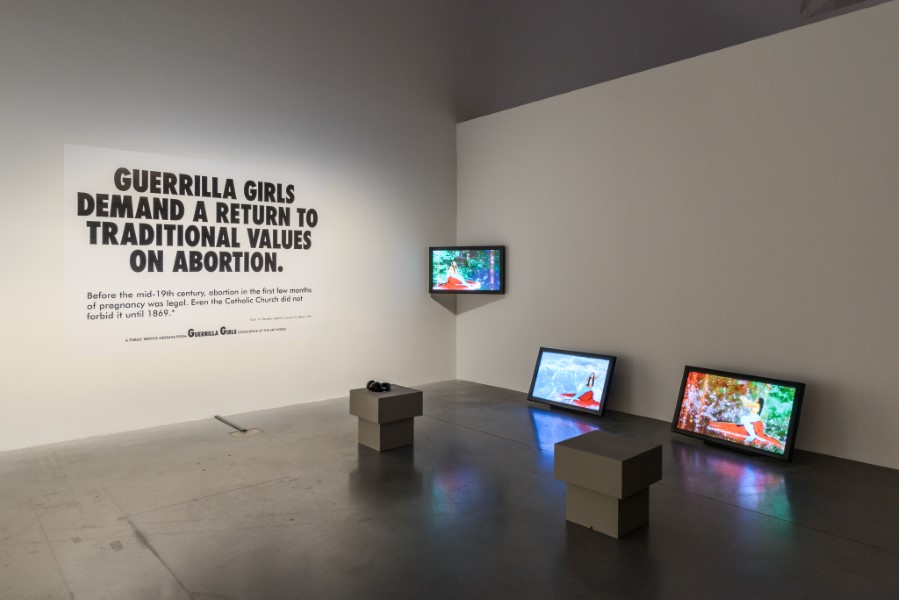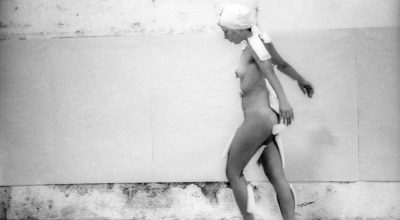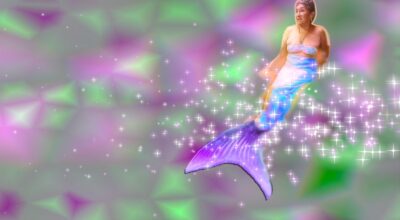
WHO WILL WRITE THE HISTORY OF TEARS. ARTISTS ON WOMEN’S RIGHTS
For over a century debate has raged over women’s reproductive rights. Differing visions of society and the state, the role of religion, and the limits of individual freedom clash. Who should have the deciding vote on this matter: the society, or women themselves? This issue can fundamentally divide people and provoke acts of aggression. The account of personal, individual experiences—and especially women’s perspective—is lost in the debate.
Who Will Write the History of Tears is an exhibition about the relations between the female body and repressive laws. The title is borrowed from a work by the American artist Barbara Kruger and underlines the arduous process of women’s pursuit of their rights. The works presented at the Museum of Modern Art in Warsaw strive to break through the impasse that has prevailed in the debate over abortion, to transcend the crisis of verbal and visual language. The aim is to wrest the topic of abortion from the control of political clichés. The artists draw on real stories and include in their works the entire spectrum of visual and poetic allusions, images and symbols, conveying the complexity of the experience of pregnancy and abortion.
For years this concrete, human experience was taboo. Speaking of it was prohibited or frowned upon. The exhibition addresses this social denial and the existential nature of this experience. “That is why we show the story of the fight for women’s reproductive rights—historical events demarcating the stages of this battle. We give voice to the participants, but also examine the theme of abortion through emotions that convey its existential and individual dimension. We can see all of this for example in the etchings by Paula Rego from 1999, Abortion Series. These scenes of suffering, abandonment and despair played a key role in the fight for reproductive rights in Portugal in 2007.”, writes the curatorial team made up of Magda Lipska, Sebastian Cichocki and Łukasz Ronduda.

The battle for women’s rights is being waged all over the world, and is linked with transformations underway in contemporary societies. The exhibition present works relating experiences of women from Argentina, Ireland, Poland, Portugal, Spain and the United States, from countries that have become the site of mass protests and heated public debate. These debates have largely—but not immediately—led to recognition of women’s full reproductive rights.
The architecture of the exhibition was created by the German architect Johanna Meyer-Grohbrügge. It alludes to the historic exhibition Womanhouse in 1972, regarded as one of the first shows of feminist art. A group of female students at the California Institute of the Arts (CalArts) renovated a house in Los Angeles slated for demolition, and, under the eye of their professors Judy Chicago and Miriam Schapiro, converted it into a surreal artistic installation, drenched in eroticism and humour, relating various spheres of women’s life. Meyer-Grohbrügge monumentalizes this domestic space, and the soft, textile architecture assumes the shape of a vagina, the “origin of the world.”


Some works in the exhibition
Mariela Scafati (she/her, born in 1973, lives and works in Buenos Aires, Argentina) is a visual artist and LGBT activist. She is the cofounder of the Argentinian movement Cromoactivismo, which draws from colour theory and the history of modernism, testing the strength of various hues during street protests and blockades (they use the Pantone palette as a “battleground of colour”).
The installation Mobilization was created for the Berlin Biennale in 2020, during the outbreak of the COVID-19 pandemic. Scafati’s abstract paintings were arranged into geometric human profiles of square and rectangular “heads”, “torsos” and “limbs”. Each of them represents a specific activist friend of Scafati’s, to which the artist assigns an appropriate colour reflecting her temperament, and the module also reflects the woman’s height. She created the work in response to the mobilisation of women’s movements around the world in 2020, during the tough times of the pandemic and restrictions on public gatherings.
In Argentina a law was adopted by parliament in the last days of the year legalising abortion up to the 14th week of pregnancy, after decades of intense work and struggle by women’s organisation (the law went into force on 24 January 2021). Initially the installation comprised marching and dancing figures. Their placement now on the floor alludes to the time of hibernation during the pandemic, and also a rest before a new march. When it comes to women’s rights, no victory is won once for all time.
Paula Rego is a Portuguese painter and illustrator. Rego grew up under the António de Oliveira Salazar regime, in a staunchly anti-fascist household. She attended St. Julian’s Catholic school in Carcavelos, and later studied art at the Slade School of Art in London.
The lithographs presented at this exhibition belong to Rego’s Abortion Series. They were created in the aftermath of the 1998 abortion rights referendum in Portugal, which failed to produce the expected legal outcome, prompting the artist to lend her support to the pro-choice movement through a series of harrowing pictures. According to the Portuguese Prime Minister José Sócrates, Rego’s pastels and lithographs contributed to the success of the subsequent referendum held in 2007. Commenting on her work, the artist observed that “It highlights the fear and pain and danger of an illegal abortion, which is what desperate women have always resorted to. It’s very wrong to criminalize women on top of everything else. Making abortions illegal is forcing women to the backstreet solution”. the work as a whole a dimension of metaphor: a metaphor of the primordial, indestructible power lurking in women – a power that despite adversity, persistently strives toward total eruption.


Fina Miralles (she/her, born in 1959, lives and works in Sabadell, Spain) is a visual artist whose works from the 1970s combined performance and conceptualism with ecological and feminist thought. Distinct characteristics of her work included its critique of patriarchy, and drawing from nature as a source of power and imagination.
The series of photographs Emmascarat (Catalan for “masked”) from 1976 recalls the oppressive living conditions for women under the Franco regime. Spain was then in the grip of a ruthless cult of the family, and the authorities, hand in hand with the Catholic Church, limited women’s civil rights, rendering them wholly dependent on their fathers, brothers or husbands (a woman could not decide on her own to work or travel). The law at that time reverted to the 19th century, relying partially on the Napoleonic Code. For example, there was no penalty for a man who killed his own wife to “punish” her for adultery, divorces were expensive and available only with the consent of church officials, and abortion was entirely banned. Miralles took these photographs shortly after the death of Franco, registering the dark emotions from the time of the dictatorship.
Your Body Is a Battleground is Barbara Kruger’s best-known work in Poland. It appeared for the first time on the streets of Polish cities in 1991 thanks to cooperation between the artist and Milada Ślizińska, a curator at that time at Zamek Ujazdowski Centre for Contemporary Art in Warsaw. This occurred at the time the Polish parliament was debating a tightening of the abortion law, which was ultimately adopted in 1993, allowing abortion in only three cases: when the life or health of the woman was endangered, when there were irreversible foetal defects, and when the pregnancy was the result of a crime.
Kruger’s work was created several years earlier, for the famous March for Women’s Lives in Washington on 9 April 1989, a protest in which American women sought to uphold the Supreme Court’s 1973 decision in Roe v. Wade legalising abortion. Who Will Write the History of Tears?, the work from which the title of the exhibition at the Museum of Modern Art in Warsaw is drawn, was created in 1987 and employs a similarly strident aesthetic. Kruger recently showed a new version of this work at the exhibition Abortion Is Normal at Galerie Eva Presenhuber, the income from which was earmarked to support Planned Parenthood, an American organisation protecting reproductive rights.


The Archive of Public Protests is a collective practising civic photography, close to the streets and the energies of social movements. A-P-P shows up for nearly every demonstration in Poland in defence of the rights of women and sexual and ethnic minorities. It also documents marches organised by nationalist and religious groups. Photos by the collective go viral in social media as a record of the everyday struggle and mobilisation of thousands of people in Poland.
The exhibition includes a selection of photos from the archive, taken since the autumn of 2020 to the autumn of 2021, when a new, uncompromising generation stepped to the fore, altering the existing language and aesthetic of protests. Crowds of protesting women and men supporting them hit the streets of Polish cities and towns. The reason for their mobilisation was the judgment of the Constitutional Tribunal holding that abortion due to irreversible harm to the foetus or illness threatening its life is unconstitutional. According to some estimates, these were the largest street protests in the history of Poland, and undoubtedly the largest civil unrest since 1989. These protests also included small towns, where demonstrations required lots of determination to confront family, friends, neighbours, the local police or the parish priest.
Elektra KB are an American artist of Colombian and Ukrainian origin, an activist for reproductive rights and the rights of sexual minorities and the disabled. Elektra KB’s works lead a double life: some of their banners are shown at museums as works of art but also carried in demonstrations, e.g. during the anti-government protests in Colombia in the spring of 2021.
A new work by Elektra KB is shown at the exhibition. The large tapestry employs several motifs characteristic of the artist’s work: female warriors (from the imaginary Theocratic Republic of Gaja), the symbol of the Red Cross, masks, and insignia of global feminist protests. The work serves as a point of contact for various narratives at the exhibition, linked with the spirit of global female solidarity. The motif of a lightning bolt used by the artist alludes to the women’s strikes in Poland. The lightning bolt present in the spaces of Polish cities, on flags, stickers, graffiti, masks and shirts, was designed by Ola Jasionowska, who also created the visual identity for the exhibition Who Will Write the History of Tears.


Rachel Fallon is a visual artist addressing themes of maternity, safety in the domestic realm, and relations between the female body and politics and religion. She uses materials and working methods associated with household chores, such as embroidery and weaving. Fallon is a member of several feminist artistic collectives.
The exhibition includes “aprons of power” used by Fallon during the Artists’ Campaign to Repeal the Eighth Amendment. One of them was used in a photographic diptych alluding to Irish women’s travels to British abortion clinics. The right to leave the country for this purpose was guaranteed by the 13th amendment to the Irish Constitution, approved in a 1992 referendum. The following words are embroidered on the inside of the apron: “To Ensure Hope Is Our Role”. According to Fallon, “These photos were taken on a Sunday morning in Bray, with my back to the Irish Sea, the same sea so many women would have had to cross to maintain their bodily autonomy”.
The photos of Fallon were taken just before the referendum of 25 May 2018, which resulted in liberalisation of the right to abortion in Ireland. For this exhibition, Rachel Fallon made a new apron in a gesture of solidarity with Polish women fighting for the right to decide about their own bodies. The piece features a slogan commonly used in Polish street protests, “For our freedom and yours”, paraphrasing a popular phrase (attributed to Joachim Lelewel) emblazoned on banners during the November Uprising.
Luiza Prado de O. Martins is a Brazilian artist, author and researcher. In her art and research she addresses issues of reproductive rights, fertility, colonialism, race and gender. In her creative work she often stresses connections between destruction of the environment, colonial history, and biopolitical control over racialised bodies.
As Flames Engulfed the River, a film essay and part of the larger work A Topography of Excesses, tells of natural birth-control practices followed by the native population of Brazil. The film begins with a reference to ayoowiri, a plant growing in tropical zones of both Americas. During the European occupation, an infusion from this plant was often used as a contraceptive, and in stronger doses as an abortifacient, by indigenous peoples as a strategy of resistance against colonial dictatorship. The sculpture A Spectre of Non Presence (2019) is an attempt to enclose in an object a performance also alluding to herbal methods of contraception. It comprises a dress used in the performance, a skirt that belonged to the artist’s mother, and a blouse that belonged to her grandmother. Other materials contained in the work, from decorative beads to seeds used for contraception, also allude to the entanglements between the stories of the women, their life and varying approaches to fertility and birth control.

WHO WILL WRITE THE HISTORY OF TEARS. ARTISTS ON WOMEN’S RIGHTS
The Museum of Modern Art in Warsaw, Wybrzeże Kościuszkowskie 22, Warsaw, Poland
26.11.2021 – 13.02. 2022
Archive of Public Protests, Artists’ Campaign to Repeal the Eighth Amendment, Anne Maree Barry, Anna Beata Bohdziewicz, Andrea Bowers, Tony Cokes, Cecelia Condit, Elektra KB, Rachel Fallon, Viola Głowacka, Guerrilla Girls, Patricia Hurl, Teresa Jakubowska, Anna Janczyszyn-Jaros, Maja Kleczewska, Dominika Kowynia, Barbara Kruger, Ewa Kuryluk, Alice Maher, Ana Mendieta, Fina Miralles, Mia Mullarkey, Małgorzata Mycek, Joanna Piotrowska, Luiza Prado de O. Martins, Paula Rego, Mariela Scafati, Agata Słowak, Elena Tejada-Herrera, Teresa Tyszkiewicz, Weronika Wysocka
También te puede interesar
Subverting The Feminine:latin American (re)marks on The Female Body
Subverting the Feminine: Latin American (Re)marks on the Female Body fue una exhibición curada por Isabela Villanueva para Y Gallery, en Nueva York, que presentó el trabajo de seis artistas latinoamericanas que cuestionan la...
Covered in Time And History:the Films of Ana Mendieta
Esta exposición en Martin-Gropius-Bau es la más completa de sus trabajos en film hasta la fecha -va acompañada de tres series de fotografías-, y marca la culminación de un proyecto de investigación conjunta de...
ELENA TEJADA-HERRERA: VOCES FAMILIARES, UN JARDÍN, UN DRON, EL AJEDREZ, Y UNA CANCIÓN
Esta exposición virtual de Elena Tejada-Herrera, curada por Gisselle Girón, reúne cinco videos, incluida una nueva producción auspiciada por el Centro Cultural de España en Lima, en cuyo sitio web se alojan. En estos...



